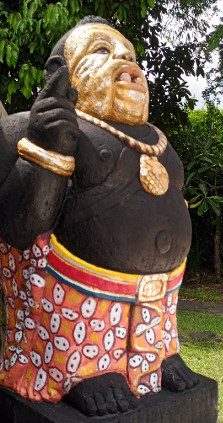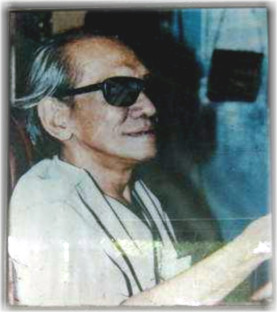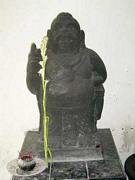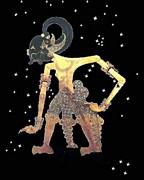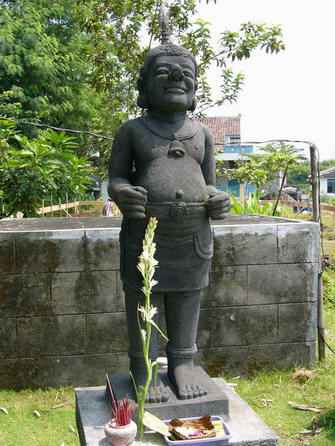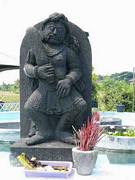Life and the scale of Observation
Yogic philosophy By Bapak Hardjanta
There are three human scales of observation corresponding to the three categories of consciousness.
- The brain-eye (mata)
- The occult-eye (pramana)
- The spiritual-eye (panon)
The brain-eye corresponds to the psycho-physical ‘I’, which includes the motor and sensory nervous system, substituted by the four drifts.
Pramana corresponds to the para-psychological ‘I’, substituted by Nyava and Suksma.
Panon corresponds to the spiritual ‘I’ which is a ray of the supercosmic essence called God.
The brain-eye is very alterable. The best evidence is: Look at a palm tree at two miles distance. The palm exists. But the brain-eye does not see it.! Put the palm on a 25 m. distance; the brain-eye will see its shape. On a closer distance of about half a meter, the brain-eye will observe the innumerable bark lines. Put the palm very near by the brain-eye and it will absorb nothing but a dark spot. So the brain-eye is relative so, the exactness of science which depends on the brain-eye must be relative too. INDEED! SCIENCE RELIES SOLELY ON THE CHANGING PHANTASMAGORIA OF THE OBSERVING BRAIN-EYE. We can say with Charles Eugiéne Guye: It is the scale of observation which creates the phenomenon. The scale of observation depends on man; it is he who creates it. In nature, different scales of observation do not exist. There is only one immense, harmonious phenomenon on a scale which, in general, escapes man. The structure of man’s brain necessitates dividing into arbitrary compartments and cutting up into isolated pieces. (quoted by Lecomte du Nouy in: Human Destiny)
With the aid of several instruments science creates more phantasmagoria: “on our scale of human observation, as pointed out before, the edge of a razor-blade is a continuous line. On the microscopic scale, it is a broken but solid line. On the chemic scale we have atoms of iron and carbon. On the sub-atomic scale we have electrons in perpetual motion which travel at the rate of several thousand miles per second. All these phenomena are in reality the manifestations of the same basic phenomenon, the motions of the electrons. The only difference which exists between them is the scale of observation” (Human Destiny, Lecomte du Nuoy.)
With all these artificially created scales of observation, has science succeeded to unveil the mystery of substance? With every step science has been revising its hypotheses. Maybe (if not surely) even the basic phenomenon, the motions of the electrons, must be revised and adapted to the only one immense, harmonious phenomenon on the pramana scale of observation in its relation to microcosmic Nyava (and macrocosmic Hyang Vidhi), which is indeed Goethe’s Weltseele (Welt Ather.)
Besides the above stated alterableness, the brain-eye lacks the ability to perceive perfectly any three-dimensional phenomenon. The three-dimensional brain-eye is only able indeed to see a PART of any three-dimensional phenomenon. Only a flat (two-dimensional) phenomenon can be perfectly seen by the three-dimensional brain-eye. Therefore we can say: any phenomenon can only be perfectly seen from a higher dimensional standpoint. In the case of three-dimensional phenomena, it can only be seen by pramana the occult eye, which is substituted by Nyava (Space as Ding an sich) and Suksma (Time as Ding an sich.) Minowsky says:
“Henceforth space by itself, and time by itself, are doomed to fade away into mere shadows, and only a kind of union of the two will preserve an independent reality.”
These fading shadows are the increasing lack of comprehension of the brain concerning a higher dimension. The present stage of scientific adventure transcends its human and artificial instruments. Only pramana, the higher dimensional human instrument can clarify chaotic scientific theorizing.
Applied to Spiritual Psychology, this saying of Minkowski states one of its fundamental laws (3rd. principle.) The union (contact and Wechsel-Wirkung) of the male or female elements of man and woman creates and preserves an independent reality (a new male or female human being), while space by itself (Nyava separated finally from Suksma) and time by itself (Suksma separated finally from Nyava) are doomed to fade away (cause of bodily death.)
Concerning the dimension of this independent reality (a new human being); the scale of vision is according to the consciousness he reaches. It is three-dimensional, if it is only aware of its psycho-physical complex. The senses of this psycho-physical complex are limited; hence we do not wonder when reading the utterance of J.W.N. Sullivan:
“There is nothing absolute about space or time.” (Limitations of Science)
Goethe says: “Der Mensch kann nicht lange in bewuszten Zustande verharren; er musz sich wieder ins Unbewusztsein flüchten; denn darin lebt seine Wurzel.”
The Wisdom-philosopher says: “Realize thyself, so that you can get an EXACT REALIZATION of thyself by the non-PHYSICAL observation of the PSYCHO-PHYSICALLY INVISIBLE roots of thy consciousness. KNOW THE ROOTS OF THY CONSCIOUSNESS NOT AS ENERGY, BUT AS MATTER. What ENERGY is for the PSYCHO-PHYSICAL senses, is MATTER for the NON-PHYSICAL senses. These non-physical senses are concentrated in the eight colours of pramana.
As stated before, pramana corresponding to the para-psychological ‘I’, substituted by Nyava and Suksma. Pramana is an occult light-centre which includes eight colours: black, red, yellow, white, green, blue, bluish (wungu) and reddish (dadu),
The meeting of Nyava- and Suksma- ray upon the colours of pramana forms the occult vision which is not limited by any three-dimensional phenomenon. If we are Suksma-conscious (Time-conscious) pramana comprises the whole cosmic history, past, present and future. If we are Nyava-conscious (Space-conscious) it comprises the immense, harmonious structure of matter.
The psycho-physical ‘I’ is not conscious of Nyava and Suksma; hence Goethe’s acknowledgement:
“Ich glaube, dasz alles, was das Genie als Genie tut, unbewuszt geschicht.” “Zwei Seelen wohnen, ach! in meiner Brust.” . .
The difference between a prophet and a genius is: the former is fully conscious of the hidden source of his psycho-physical ‘I’, the latter is unconscious except a sudden flush of thought, which he calls inspiration, intuition or super-consciousness.
What are the two souls of Faust if they are not Nyava and Suksma?
The best evidences of the perfection of the super-vision of prophets is delivered by Maxwell in his treatise: “Sedikit waktu lagi” (Indonesian translation A little more time.) Reading this booklet, we are startlingly struck by the outlook of Daniel, St. John and the other prophets. Through thousands of’ years their political predictions has been fulfilled up to the minute. What kind of measurement did the prophets utilize if it was not Nyava- and Suksma- measurement?
J.W.N. Sullivan, after stating the dispersion of scientific theorizing, admits: “The fact that science is confined to a knowledge of structure is obviously of great “humanistic” importance. For it means that the problem of the nature of reality is not prejudged. We are no longer required to believe that our response to beauty, or the mystic’s sense of communion with God, have no objective counterpart. It is perfectly possible that they are, what they have so often been taken to be, clues to the nature of reality. Thus our various experiences are put on a more equal footing, as it were. Our religious aspirations, our perceptions of’ beauty, may not be the essentially illusory phenomena they were supposed to be. In this new scientific universe even mystics have a right to exist,” (Limitations of science)
Not only J.W.N.Sullivan, but the whole system of modern education shows its lack of understanding concerning the indispensability of mystics, of which intuition is only one facet in the process of discoveries, inventions and creations. Very typical is Mozart’s testimony: “I do not know myself and can never find out.”
And yet! without intuition, neither discovery, invention nor creation comes into being. P.A. Sorokin, in his standard work, “Society, Culture and Personality”, expresses the importance of this commonly neglected truth as follows:
” Intuition is the Ultimate Foundation of Science, Philosophy, Ethics and the Fine Arts. Besides being the initiator of original conceptions, intuition serves as the foundation of the validity of the basic propositions not only of religion, ethics, philosophy and aesthetics but also of mathematical-logical and scientific thought.
To summarize: The cooperation of the senses, of reason and of intuition, is indispensable for the conception of original systems in all fields of culture. As Edison put it, the inspiration or intuition must be supplemented, developed and tested by “perspiration”, by a vast amount of empirical observation and logical or mathematical reasoning.”
Intuition, senses and reason form the trinity-principle in the process of discoveries, inventions and creations.
In the universities one can only get knowledge from empirical observation and logical or mathematical reasoning, while the development of inspiration is wholly neglected. The development of intuition inevitably and ultimately leads to mystics, and mystics are banished to the domain of superstition ! ! !
Every scientific step is led by inspiration! (Goethe, Mozart, I. I. Sikorsky, H. Poincare, G. Birkhoff, Chopin, Tchaikovsky, Edison, etc.)
Considered from the standpoint of inventions, discoveries and creations, the present system of modern education is insufficient. P.A. Sorokin endorses the: “Necessity of All Three Forms of Cognition.”
If by intuition (or inspiration) we mean a sudden, direct and valid initial conception of a new system occurring spontaneously in the mind of the conceiver; by reason, a constant, logical mathematical, syllogistic (or dialectic) process of thinking of the idea through in its inductive, deductive, analytical and synthetic aspects; and by sensory experience, a perception of the sensory phenomena related to the idea and a sensory verification of it through empirical evidence (experimental, observational, statistical and practical), then all three types of mental activity are necessary for the discovery, creation, or invention of a significant cultural system. NEITHER INTUITION NOR REASON, NOR EMPIRICAL EXPERIENCE ALONE IS SUFFICIENT. Innumerable scientists have spent their lives in an empirical (sensory) study of phenomena without achieving any notable discovery. Multitudes of teachers of philosophy, logic, and mathematics have failed to conceive any new philosophical, logical, mathematical or other system. There have been millions of intuitive daydreamers, who, having stumbled upon an idea, have failed to clarify, develop, verify and apply it in constructing an original system. TRULY CREATIVE THINKERS HAVE BEEN FORTUNATE IN POSSESSING AND EXERCISING ALL THREE TYPES OF MENTAL ABILITY.
What hypnotizes mankind is not scientific theorizing with its “perfect disorder” as in quantum theory, the pointer-reading of Eddington, or the law of probability which should supersede the law of causality. It is THE SUCCESS OF APPLIED SCIENCE which holds mankind in its grip like the eyes of a snake hypnotizing a mouse. In other words: The dominating influence of science upon mankind is due solely to the “material products” of applied science. These material products are the product of scientific research. And scientific research cannot bear fruits if it is not led by inspiration. There is no university which gives its students the opportunity and the knowledge to develop inspiration.
One may ask: “Is there any system of developing inspiration?” Wisdom-philosophy answers: “Yes there is!” IT IS THE ONE, NOT TO BE SEPERATED, WAY OF CREATIVE THINKING AND MYSTICAL EXPERIENCE.
In the history of universities, only the school of Samos gave to mystics their just place in scientific endeavoring. The Pythagorean educational system is comprised of both spirit and intellect (comp. Philosophische Mystiek by Dr. A.Vloemans.)
Now scientists are talking and discussing about the ‘crisis of the universities.’ The growing bulk of scientific branches make it impossible for anyone to master all scientific subjects. The progress of science goes hand in hand with the growing amount of specialization due to a limitation of the brain-energy. As clearly expressed by José Ortega y Gasset:
“It would then be seen how, generation after generation, the scientist has been gradually restricted and confined into narrower fields of mental occupation. But this is not the important point that such a history would show, but rather the reverse side of the matter: how in each generation the scientist, through having to reduce the sphere of his labour, was progressively losing contact with other branches of science, with that integral interpretation of the universe which is the only thing deserving the names of science, culture, European civilization,” (The Revolt of the Masses.)
At the present stage the universities are only able to create man with one portion of knowledge only, while the whole structure of science has escaped his mental vision. Besides this narrowed mental vision, the modern scientist is also deprived of sociological knowledge since sociology has been becoming a profession. Indeed the modern scientist is a stranger in his own society.
In our opinion, the method to supersede the crisis of the universities is: to give every student the opportunity to practice (psychological praxis) and know of a Life-Philosophy, which is comprised of the relation of man, society, cosmos and God.
We agree with Max C. Otto when he persists that philosophy is the concern of everyman rather than of professionals alone. (See Science and the moral Life.) But that philosophy must be as stated above and not the philosophy as existing in the mind of a J. Jeans, which discredit man’s role in the realm of cosmic existence. That Life-Philosophy must be a psychological praxis, humanity’s mighty effort to balance with a God, which reconciles society and cosmos. Or, if we borrow Goethe’s words: “Nemo contra deum nisi deus,” (Ein Gott kann nur wieder durch einen Gott balanziert werden.)
In Indonesia this psychology-praxis has always been the concern of nearly every person. It is indeed the moral duty of everyone after his daily duty to look for the (SPIRITUAL) key of the (SPIRITUAL) door in which (THE PSYCHO-PHYSICAL) one cannot find a key.
One is to be blamed if he cannot unravel the (SPIRITUAL) veil through which (THE PSYCHO-PHYSICAL) one may not see.
Whitehead says that the justification for a university is that it preserves the connection between knowledge and the zest of life, by uniting the young and the old in the imaginative consideration of learning. Imagination is represented by the young, experience by the old. (The aims of education.) According to Whitehead, youth is imaginative. Imagination in cooperation with intellectual experience in researche leads to inventions discoveries and creations.
Wisdom-Philosophy knows that imagination is the (“psycho-magnetic”) induction of Nyava and Suksma upon the consciousness. So it is not in the least the virtue of the young. IT IS THE VIRTUE OF ANYONE WHO FOR A MOMENT CAN RULE OUT (CONSCIOUS IF HE IS AN ADEPT, UNCONSCIOUS IF HE IS A WESTERN GENIUS) RELATIVE THINKING AND PSYCHO-PHYSICAL AWARENESS FROM HIS CONSCIOUSNESS, SO THAT IT IS ABLE TO REFLECT NYAVA AND SUKSMA, THE HUMAN NON-RELATIVE SPACE AND TIME PRINCIPLES, WHICH COMPRISE THE EVOLUTION OF HUMAN, SOCIAL AND COSMIC EXISTENCE.
There is a saying:
“The prophetic soul of the wide world Dreaming on things to come,” (Limitations of Science.) If that soul should not be Nyava and Suksma, it must be the Freudian dream as a wish fulfillment. But Wisdom-Philosophy rejects Freud’s Libido as the ultimate principle; thus it must be Nyava and Suksma.
"Indeed it is!" says Ronggovarsito: "Tan smar pamoring Suksma, Sinuksmaya vinahya ing asepi, Sinimpen telenging kalbu Pambukaning varana Tarlen saking liyep-layaping aluyut, Pinda pesating supena Sumusuping Rasa Jati. Kang vus vaspada ing patrap, Mangayut ayat vinasis Vekasan wosing jivangga, Melok tanpa aling-aling Kang ngalingi, kaliling, Venganing rasa tumlavung, Keksi saliring jaman, Angelangut tanpa tepi, yekuaran tapa-tapaking Yang Suksma."
Freely translated and explained:
(He) knows very well how to reach Suksma consciousness; it can only be realized if there is silence in his heart, for Suksma is veiled in the very depth of the heart; the indispensable condition for the unraveling of the veil is, that state of consciousness which is called: half asleep; if this requirement is Suksma realization, it is accomplished as fast as a dream-process.
One who is skilled in the art of upheavalling (raising up) his consciousness is able to realize immediately Suksma-consciousness, in which state the divine voice is to be heard; Suksma can be seen unveiled if one has reached that state of consciousness which is called: empty dreaming; the psycho-physical complex which forms the veil separating the three-dimensional consciousness from the higher ones can be seen; besides this, one also sees history, past, present and future, for he has united his consciousness with Time (Suksma);
THIS PROCESS OF HALF ASLEEP AND OF EMPTY DREAMING IS CALLED TAPA TAPKING YANG SUKSMA.
What the western genius realizes merely by chance is, in Indonesia, the first steps in Spiritual Science. The Western genius acknowledges that ideas come when we least expect them. Wisdom-Philosophy knows that man’s consciousness behaves as a mirror (see DevaRuchi.) Man is what he is conscious of! He remains an emotional and instinctually thinking animal, if he is only conscious of and reacts to psycho-physical stimuli! In other words, if his consciousness only reflects the external world. He is imaginative (in the style of Whitehead), inspirational (to use Edison’s terminology), intuitive (I.I. Sikorsky’s experiences) if all his psychological activities are unconsciously ruled out for a moment so that his consciousness which behaves as a mirror is momentarily clean. In this moment it is able to reflect the influence of Nyava and Suksma. His consciousness is transformed into creative thinking for a moment. Very peculiar is the acknowledgement of H. Stafford Hatfield:
“Creation often comes from persons endowed with none but the most mediocre mental powers. When the great creative personality exhibits some or all of the qualities we have enumerated we repeatedly get the impression that they are secondary, and acquired under the urge of the creative drive; not primary, as in the highly accomplished, but uncreative,” (The Inventor and His World.) Taking into account the facts that:
- Our brain-energy is limited and
- A university must be imaginative (according to Whitehead a university is imaginative or it is nothing – at least nothing useful)
it is of great importance to reduce the bulk of subject matter to the indispensable amount and to instruct the students with the laws of Spiritual Science which comprises too the art of creative thinking. We reject Hatfield’s statement that it is quite futile to lay down any rules concerning invention, for the inventive drive is only a “subdivision” of Spiritual Science. And truly there are rules in Spiritual Science which, cannot be violated at any price! Man obeys the rules lest he loses his spirituality. The following acknowledgement of Hatfield is one of the not to be violated rules in Spiritual Scientific Praxis: “And then out of the depths of the unconscious mind comes a suggestion, a vision of a new form; one perhaps, which seems paradoxical, absurd; but scrutiny or experiment shows it to be the sought for solution and remedy.”
The anecdotes of these “flashes of inspiration” are endless. But there is no one who has not experienced exactly the same mental state. We seek in vain for a name or an expedient; we cudgel our brains without result. Finally we let the matter drop, and behold! the name or other matter we have striven in vain to remember flashes into our minds, bringing with it sense of relief. Precisely thus does the long-sought solution visit the mind of the inventor, the new melody the mind of the musician, the original phrase the mind of the writer. The process of creation is no more conscious than is the creation of new species or new mutations.”
If the “letting drop of matter” is accomplished consciously and not only for a moment, if the cleaning of the consciousness occurs consciously and the duration of this state of consciousness is at the will of the executor, he is a skilled magician, able to influence “inanimate” and “living” matter. Concerning the possibility of “working from a distance,” we know from bio-chemistry that the body-mechanism (brain, nerves system and muscles) is substituted by electric currents. The psycho-physical ‘I’ is indeed a transmitting and receiving electric power-station. The skillful magician is able to stop the psycho-physical transmission and reception and by this act LIBERATES HIS ELECTRIC ENERGY FROM THE PSYCHO-PHYSICAL NETWORK. ONCE LIBERATED IT OPERATES THROUGH THE PRAMANA-NETWORK IN THE EXTERNAL WORLD. In the Indonesian (Javanese) literature (Kidungan and other works) the liberated electric energy is described as blazing lightening.
God’s consciousness is reached by liberating the consciousness from the awareness of pramana, Suksma and Nyava. There is an Indonesian (Jav.) saying which gives a clear notion of the Indonesian concept of life: “Urip iku chedak, luvih chedak katimbang avak, nanging ora sénggolan.”
Translated: “Life is very near, nearer to you than to your body, but it does not touch you.” Long before the invention of the dynamo, Wisdom-Philosophy knows that Life behaves as a magnet. The network of brain, nerves system and plexus solaris is the coil in the lamp; the human behavior is represented by the light of the lamp, and the life-drifts are to be found between the poles of the magnet as the turning coil. In the Indonesian society, the saying “Be dead while you are still alive” is very popular. This commandment is extracted from a verse of R..Ng.Ronggovarsito in one of his prophetic works: “KALATIDA.” The whole verse which contain the name of the author in codified form is as follows:
"Sageda sabar santosa. Mati sajroning ngaurip. Kalis ing reh haru-hara. Murka-angkara sumingkir. Tarlen meleng malat-sih. Sanityasèng tyas mamtuh. Badaring sapu-denda. Antuk mayar savatavis. BoRONG angGO saVARga mèSI marTOyo (ya.)"
Freely translated:
“If you are longing for forgiveness in this mad epoch, be patient (do not react upon psychological stimuli) and be strong of will; these conditions are indispensable for the reaching of that state of consciousness which is described as: Be dead while you are still alive. In this state of consciousness you are free from lust and anger; the calamitous influence of the social intricacies too cannot affect you. By your strong will you are and ought to be able to hold up that state of consciousness, which is necessary in order to reach heaven. And in heaven you will find life-elixir. Only on these conditions can you be liberated from the wrath of God, and get forgiveness.”
Let us consider this verse from the standpoint of the magnetic behavior of Life:
Lust and anger, and all psychological activities are only emanations of the life-drifts. The activity of these life-drifts is similar to the turning of the coil between the poles. In Spiritual Science the Art is to stop the activity of the life-drifts (the turning of the coil.) This results in the stopping of all psychological activities, including lust and anger. The consciousness, which behaves as a mirror, is now clean from psycho-physical and para-psychological images and stimuli; the “veil (through which we may not see) is unraveled.” This consciousness reflects the Trinity-Life.
We are on the “threshold” of heaven! Wisdom-Philosophy pretends that heaven can be realized during this world-life. Heaven is not only a realization after the decomposition of the body. It is not the problem for a dim future but the problem of now! R..Ng, Ronggovarsito even goes further by saying: “If you are not able to reach eternity during this world-life, you never shall find out The Way during your death-struggle. You remain a pagan! (S. Sopanalaya.)
According to Wisdom-Philosophy, eternity is the culmination point in the process of upheavalling one’s consciousness, while death is only the decomposition of the body-mechanism, which is caused by being “worn-out” through the years or by an irreparable defect in the network of the vital nervous system and muscles (in the coil.) Man is what he is conscious of. A theologian, with a perfect knowledge of all religious organizations, remains a pagan if his consciousness is not deepened (heightened.) On the contrary one with the slightest knowledge of religious organizations, is a convert if his consciousness deepens (heightens) to the culmination-point: eternity, by means of stopping the psychological and para-psychological activity. Deva-Ruchi speaks to Bima:
"Liré mati sajroning ngaurip, Iya urip sajroning palastra, Nanging urip salavasé, Kang mati iku napsu, Badan lahir ingkang nglakoni, Katampan badan nyata, Pamoré savujud, Pagene ngrasa matiya Verkudhara ing tyas padang anampani, Nenggih ingkang nugraha."
Freely translated and explained:
“What I mean by the commandment: “Be dead while you are still alive and live the Eternal Life in that state of death,” is that the life-drifts must be dead (at rest, non-active.) What remains, is: the biological function of man which is immediately substituted by Trinity-Life. Verkudhara comprehends this teaching (which leads to salvation); his consciousness is enlightened.”
The psycho-spiritual accomplishment as stated above is called “Dauping kavela lan Gusti” (The marriage of man and God.) The Indonesian conception of this spiritual marriage is very characteristic. It is symbolically described as the “child” who is the result of a well-succeeded marriage of a man and a woman. (Jav. Jodo); the “plant’ as the result of the marriage of seed and earth; the “brick” as the result of the marriage of earth and fire. The “child’ is neither the mother nor the father; the “plant” too is neither seed nor earth; in the case of the “brick” it is also neither earth nor fire. The marriage of man and God is indeed an alchemical compound by which the common relationship between man and God, as related in all religions, altogether disappears. In other words, the acts of a human deva (one who has already accomplished spiritual marriage) are neither subjugated to award nor to punishment, for the simple reason that award and punishment are only applicable to man. A human deva is only externally similar to man; internally operated by the divine forces.
Now we can give a new definition of a prophet or an avatar. A prophet is one who tries to solve the social problems by means of the faculties of the spiritual marriage. What is the background of the miracles of prophets, avatars and sujanas? Long before the discovery of radioactivity by Becquerel and Curie, Wisdom-Philosophy knew perfectly about the radioactive behavior of Life. In the Indonesian literature it is called: KAMUKSAN. It is the faculty of the spiritual ‘I.’ The way to attain and utilize this radioactive human element is very clearly shown by Deva-Ruchi:
"Manava dumadining sakalir, Kang awit saking obahing karsa, Ana uga pakolèhé, Saking obahing kayun, Chekaké manusa puniki Pathoké vani pejah, Namun vedhi lampus, Sabarang nora tumeka, Sedhyanira chupet anchasé tan dhadhi, Marma lamun inguchap. Luvih gengnya KALEPASAN iki, Lavan jagad ageng KALEPASAN, KAIVIUKSAN luvih lembuté, Salembutaning banyu, Maksih lembut KAMUKSAN iki, Luvih alit KAMUKSAN, Saäliting tengu, Pan isih alit KAMUKSAN, Liré luvih amisésa ing sakalir, Liré lembut alitnya. Bisa nuksma ing agal lan alit, Kalimputan sagung kang rumangkang, Gumremet uga tan pahé, Kaluvihan satuhu, Luvih déning ingkang nampani, Tan kenèng ngandhelena, Ing varah lan vuruk, Dhèn sanget pangudhinira, Raganira vasuhen praptanya ngungkin, Vruha rungsiting tingkah.
Freely translated and explained:
“KALEPASAN is greater than cosmos; it is Supercosmos as Ding an sich. KAMUKSAN is very small; it is smaller than a proton of hydrogen. It is a supercosmic point. Thanks to its supercosmic nature it governs all matter; it is also able to penetrate microcosmos (the world of nuclear physics) and macrocosmos (the world of astronomy); in other words, it is radioactive and dominates organized life. One who has attained KAMUKSAN is superior (the just terminology is having reached the deva-state), and needs no instruction from anyone.
So, strive with all your power to reach that state of consciousness by subjugating the psycho-physical instinctive and sensory impulses which substitute all dominating psychological phenomena, to your will. Be dead while you are still alive, lest you never shall reach your goal: KAMUKSAN. Be upon your guard against the intricacies of spiritual endeavoring ! !”
Once more are we confronted with the commandment: Be dead while you are still alive. It is indeed the not to be violated Law in Spiritual Science. In practical life, if one gets his diploma in a branch of knowledge, he is still able to deceive another by showing his diploma. In Spiritual Science this is an impossibility. God is not to be deceived and is inexorable. Chenthini (the standard work of Ronggosutrasno) declares: “You may speak so that your mouth spits fire; it shall have no spiritual, effect at all.” On the contrary: “Blessed are the pure in heart: for they shall see God,” (The Sermon on the Mount.) Blessed is the one who is dead while he is still alive, for by purifying his consciousness he reflects Trinity-Life and is able to utilize the radioactive faculties of God; he can command and transform the cosmic elements. “SURA-SUDIRA JAYANIKANANG RAT, SYUH-BRASTHA TKAPNING ULAH DHARMASTUTI.” (Niti.Sastra), The translation of which is as follows:
The accomplishment of this mighty human endeavouring in Spiritual Science, which is called: Dharmastuti is the one-without-a-second solution of the dominating problem aroused by the existence of atomic weapons. Thanks to the existence of the annihilating danger of atomic weapons mankind is compelled to revise its materialistic conception of life and to turn back to God, the Supercosmic Deity, if it intends to surpass the modern consciousness of being hopelessly subjugated by its own creation. The question is now: How can we ease this mighty, human effort of upheavalling the consciousness? The answer is: By just conduct! which is threefold of nature:
- for the layman.
- for the magician.
- for the adept.
For the layman the just conduct is divided into three categories:
- the physiological conduct.
- the psychological conduct.
- the social conduct.
- The physiological conduct:
Correcting the ordinary respiration-system. There are four methods of respiration:
- Breast respiration
- Rib respiration
- Belly respiration
- Milt respiration. (below the belly a bit to the left side)
There is a saying in “Vedatama”:
“Know the ingredient of worship which is paid continuously day and night. Learn the nature of this ingredient from Sarjanas who live according to the rules of purity.”
This ingredient, now, is the art of just breathing. Neither prayer nor meditation can be continuously practiced. What we always do in wake and sleep is: “Breathing.”
The dictionary says that breath is synonymous with vital spirit. Indian Philosophy takes it literally: “It is the spirit of life.”
Science states that breathing is indispensable for the oxygenation of the blood, and oxygen is essential to all life.
What is sure is that breathing is indispensable for the existence of the psycho-physical complex. Recently scientific investigations admit that the holding of breath between inhilation and exhilation is very important for the increasing of the oxygenation process. So it recommends the Indian system of breathing for the maintaining of health, deprived of its mystical element.
The Indonesian conception concerning the art of just breathing is as follows:
According to Vedatama, only Sarjanas who have reached purity of consciousness, know the art of just breathing. Purity of consciousness means the outruling of the influence of the psycho-physical complex from the consciousness. So the art of just breathing must be UNCONSCIOUSLY performed. Considered from this standpoint, the artificial controlling of breathing must be rejected, because it implies a concentration of the mind upon an object: the controlling of breathing, which will be an obstacle for the last stage of Yoga: the A-samprajnata samâdhi (means objectless samâdhi.) Moreover, the act: controlling can never be unconsciously performed.
BREATHING MUST NOT BE CONTROLLED, BUT CORRECTED. This corrected breathing must remain an unconscious, usual mode of action.
Just breathing and purity of consciousness link together (see the statement in Vedatama.) So, wrong breathing and impurity of consciousness must link together too. This impurity is formed by the influence of the psycho-physical complex. In other words: The quality of breathing is the “barometer” of the quality of the psychophysical complex. Any change in the psycho-physical complex is always accompanied by a change of breathing. For example:
An impulse, provoked by the sudden apprehension of an external phenomenon is always accompanied by a sudden change of breathing.
A deep, dreamless sleep is always accompanied by deep breathing (belly respiration.) A restless sleep, full of terrible mental images, is always accompanied by a short and rough breast respiration.
Recent, scientific investigations prove the validity of the Indonesian saying that breath is the wind of the body-mechanism. A short, strong, fast and rough wind: a gale causes damage in the world. A short, strong, fast and rough breathing causes damage too in the psycho-physical complex. On the other hand, a deep, quiet, slow and smooth breathing stimulates the process of psycho-physical relaxation, leading to final outruling of it in the process of upheavalling one’s consciousness. (compare the experiences of W. Brown stated in: Oxford Essays on Psychology.)
William Brown, with more than 50 years experience, further maintains that holding the breath after normal expiration, thus in contradiction of the yoga method, has the maximum effect. His concept approaches the Indonesian concept, for the holding of the breath after exhilation has as a result: an automatic, deeper inhalation. As a scientist he is merely concerned with the physiological aspect of respiration. Positively said: His aim is only the recuperative effects of rest and neuro-muscular relaxation. Whereas, in Spiritual Science this end is only the beginning. It is only one of the means to ease the process of upheavalling the consciousness. Brown’s method satisfies the physiological aim; whereas in Spiritual Science, as said before, any psycho-physical activity (including the act of holding the breath) must be avoided. Instead of holding the breath with the effect of deepening it thereafter, Spiritual Science utilizes this effect as its usual method: the under-belly or milt-respiration (see above.) This method comprises the other three systems. This must, as much as possible, be exercised so that it becomes an unconscious, usual mode of action. Summarizing we say:
“THE INGREDIENT OF WORSHIP CONSISTS OF A SLOW, QUIET AND SMOOTH MILT-RESPIRATION.”
For the purpose of easing this exercise, A MODERATE DIET IS IDEAL, for if we have eaten too much the respiration-muscles lose much of their elasticity.
The golden rule is:
“UTILIZE ANY LEISURE TIME FOR THE EXERCISE OF MILT-RESPIRATION SO THAT IT BECOMES AN UNCONSCIOUS, USUAL MODE OF ACTION.”
b) The physiological conduct during the process of upheavalling the consciousness:
- the bodily conduct
- the muscular conduct
- the ocular conduct
- Sitting or lying on the back, the body must be straight.
- Avoid any muscular strain. All muscles must relax.
- The pupils must be directed on the top of the nose.
The West says: “The eye is the mirror of the soul.” More justly:
“The eye is the mirror of the external phenomena.”
If our consciousness is drawn outwardly by an external phenomenon, it is always accompanied by an ocular activity:
- The eye movement to the left or right side, upwards or downwards.
- The adaptive activity of the pupils.
On the other hand, if the consciousness is drawn inwardly by falling asleep for example, the eye is non-active and steady.
THE MOTION AND ACTIVITY OF THE EYE AROUSE A PSYCHOLOGICAL ACTIVITY, which is electric in its nature and thus must be avoided, because, as said before, the upheavalling of the consciousness is a process of liberating and sublimating the human electric energy. So ALL PSYCHO-PHYSICAL ACTIVITIES INC. THE OCULAR MUST BE AVOIDED.
The top of the nose is the invisible point in the external world. To stare at this point means to stare at nothing, which is just the aim of our trying: the outruling of the external phenomena.
THE OCULAR CONDUCT AS STATED ABOVE HAS THE MAXIMUM STIMULUS AND EFFECT, IN THE PROCESS OF OUTRULING THE PSYCHO-PHISICAL COMPLEX. Ordinary man reaches this state of consciousness by a deep, dreamless sleep. The art is now to reach a “CONSCIOUS SLEEP.” In order to ease our effort in this direction, we must choose the most suitable time if we are tired or if we have to sleep. “HALF ASLEEP,” the INSPIRITIONAL MOMENT of the genius is only a fragment of this “CONSCIOUS SLEEP” and yet in it, we are able to stimulate the scientific progress revolutionarily . . . . .
There are three times a day which best meet our aim:
- After daily work, when the psycho-physical complex automatically begins to relax.
- Before going to sleep.
- Immediately after sleep, when we are still in that state of ‘half asleep.’
The daily psychological conduct:
This consists of 13 points, and here again it must be emphasized that these points are only means to ease the upheavalling process of the consciousness from the three-dimensional state to higher dimensions. It is the psychological daily exercise of broadening the consciousness and of diminishing the influence of the psycho-physical complex.
The 13 points are as follows:
- Never feel insulted (ayva dharbé esak-serik)
- Be always contented (narima)
- Be always true (temen)
- Avoid poverty of heart (nyepena nistha lan nisthip)
- Annihilate the inclination to lie (anyirnakna ati goroh)
- Be patient and indulgent all suffering (sabar)
- Be peaceful (alim)
- Be merciful and take your refuge to God (ngapura sasaminipun, tuvakupa mring Hyang Manon)
- Be humble (marta)
- Be generous of heart (legava)
- Be steady and inert of heart (santosa)
- Be careful (ngati-ati)
- Avoid fear and anxiety (ayva vas sumelang galih) (as outlined by Sopanalaya.)
The social conduct too has the same purpose as the psychological. This consists of 8 points, which are as follows:
- Be true towards others (temen)
- Never show poverty of heart (nyepena nistha lan nisthip)
- Be tolerant towards others (sabar)
- Be peaceful (alim)
- Be merciful towards others (ngapura sasamanipun)
- Enlighten others by words and deeds (gelara marta martani)
- Do not hurt others (ayva munasikèng janmi)
- Be charming and guard the heart of others (amonga atining uvong) (Sopanalaya.)
The just conduct of the magician:
Follow scrupulously the hints and instructions of the colour- and light-centres, avoid fear and anxiety, aroused by the external phenomena and your consciousness will remain illumined (Sopanalaya.)
The just conduct of the adepts:
Be steady and strong in the holding of the principles of Life. Utilize of the faculties of God. Rely solely upon all these faculties (Sopanalaya.)
To summariz we may say:
By sublimating the human electric energy man becomes a magician;
By sublimating Nyava- and Suksma-energy man becomes an adept,.
To the earnest student we give the motto:
“Vergeudo keine Energie!’
Veredle sie!

